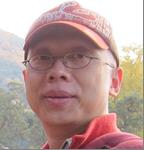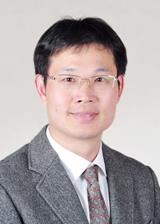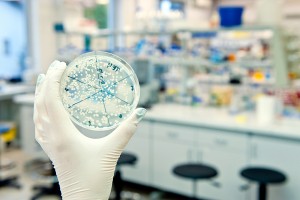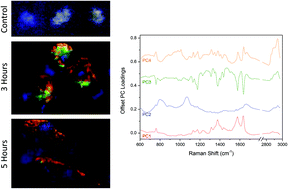Congratulations to S. Dasgupta and Neha Thakur who won oral presentation awards from Analyst at the recent Current Trends in Analytical Chemistry (CTAC-2015) meeting, held by the Association of Environmental Analytical Chemistry of India (AEACI) in Mumbai, May 26-29. Each were given book vouchers to use in the Royal Society of Chemistry books catalogue.
• First Prize:
S. Dasgupta, ACD, BARC, Variable Energy Cyclotron Centre, Kolkata. Talk title: Compositional characterization of Cu-Cr-Zr alloy and Lithium Titanate by CPAA using proton beam from VEC accelerator.
• Second prize:
Neha Thakur, ACD, BARC, Mumbai. Talk title: Development of an Optode Film for Instant Detection of Zinc (II) Ions in Aqueous Solutions
Congratulations to Analyst award winners at CTAC-2015, Mumbai, India
Gordon F. Kirkbright Bursary Award, 2016

Gordon F. Kirkbright Bursary Award, 2016, now open for nominations
The Gordon F. Kirkbright bursary award is a prestigious annual award that enables a promising student/non-tenured young scientist of any nation to attend a recognised scientific meeting or visit a place of learning.
The fund for this bursary was established in 1985 as a memorial to Professor Gordon Kirkbright in recognition of his contributions to analytical spectroscopy and to science in general. Although the fund is administered by the Association of British Spectroscopists (ABS) Trust, the award is not restricted to spectroscopists.
Applications are invited for the 2016 Gordon Kirkbright Bursary.
For further information contact John Chalmers at, email: vibspecconsult@aol.com
The closing date for entries is 31 December 2015.
HOT articles in Analyst
Take a look at our most recent HOT Analyst articles, these are now free to access for the next few weeks!
Superposition of an AC Field improves the discrimination between peptides in nanopore analysis.
Elisabet Jakova and Jeremy S. Lee
Analyst, 2015, Advance Article
DOI: 10.1039/C4AN02180K
Versatile G-quadruplex-Mediated Strategies in Label-Free Biosensors and Logic Systems
Jiangtao Ren, Tianshu Wang, Erkang Wang and Jin Wang
Analyst, 2015,140, 2556-2572
DOI: 10.1039/C4AN02282C
Label-free and highly sensitive electrochemiluminescent biosensing using quantum dots/carbon nanotubes in ionic liquid
Wenwen Tu, Xuelin Fang, Jing Lou and Zhihui Dai
Analyst, 2015, 140, 2603-2607
DOI: 10.1039/C4AN02129K
Analysis of fast channel blockage: revealing substrate binding in the microsecond range
Igor Bodrenko, Harsha Bajaj, Paolo Ruggerone, Mathias Winterhalter and Matteo Ceccarelli
Analyst, 2015, Advance Article
DOI: 10.1039/C4AN02293A
The potential of chiroptical and vibrational spectroscopies of blood plasma for the discrimination between colon cancer patients and the control group
Michal Tatarkovič, Michaela Miškovičová, Lucie Šťovíčková, Alla Synytsya, Luboš Petruželka and Vladimír Setnička
Analyst, 2015, 140, 2287-2293
DOI: 10.1039/C4AN01880J
Drop-by-Drop Chemical Reaction and Sample Introduction for Capillary Electrophoresis
Fengming Chen, Ying Rang, Ying Weng, Luyao Lin, Hulie Zeng, Hizuru Nakajim, Jin-Ming Lin and Katsumi Uchiyama
Analyst, 2015, Advance Article
DOI: 10.1039/C5AN00040H
The role of lipid droplets and adipocytes in cancer. Raman imaging of cell cultures: MCF10A, MCF7, MDA-MB-231 compared to adipocytes in cancerous human breast tissue
Halina Abramczyk, Jakub Surmacki, Monika Kopeć, Alicja Klaudia Olejnik, Katarzyna Lubecka-Pietruszewska and Krystyna Fabianowska-Majewska
Analyst, 2015, 140, 2224-2235
DOI: 10.1039/C4AN01875C
Label-Free Free-Solution Nanoaperture Optical Tweezers for Single Molecule Protein Studies
Ahmed A. Al Balushi, Abhay Kotnala, Skyler Wheaton, Ryan M. Gelfand, Yashaswini Rajashekara and Reuven Gordon
Analyst, 2015, Advance Article
DOI: 10.1039/C4AN02213K
A step towards Mobile Arsenic measurement for surface waters
C. A. de Villiers, M. C. Lapsley and E. A. H. Hall
Analyst, 2015, 140, 2644-2655
DOI: 10.1039/C4AN02368D
Gold nanorod-based localized surface plasmon resonance platform for the detection of environmentally toxic metal ions
Subramaniam Jayabal, Alagarsamy Pandikumar, Hong Ngee Lim, Ramasamy Ramaraj, Tong Sun and Nay Ming Huang
Analyst, 2015, 140, 2540-2555
DOI: 10.1039/C4AN02330G
Congratulations to Analyst award winners at the National Analytical Chemistry Conference
Congratulations to Professor Xingyu Jiang (National Center for Nanoscience and Technology) and Professor Chaoyong Yang (Xiamen University) who received awards sponsored by Analyst at the National Analytical Chemistry Conference, Wuhan, 11 – 14 May 2015, to recognise their significant contribution to the analytical sciences..
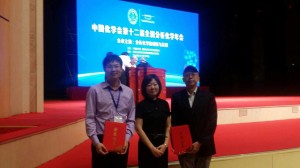
Professor Chaoyong Yang (Left) and Professor Xingyu Jiang (Right)
Professor Xingyu Jiang
Xingyu Jiang is a Professor at the National Center for NanoScience and Technology (NCNST), China. He obtained his BS at the University of Chicago (1999) and PhD at Harvard University (with Prof. George Whitesides, 2004). After a short postdoctoral fellowship with Prof. Whitesides, he returned to work in the NCNST in 2005 and has remained there since. His research interests include surface chemistry, microfluidics and nanoparticles and their applications for analytical sciences. He was a Young Investigator awardee of the Human Frontier Science Program. He was enrolled in the “Hundred Talents Plan” of the Chinese Academy of Sciences, he was awarded the National Science Foundation of China’s “Distinguished Young Scholars” Award, the Scopus Young Researcher Gold Award, the Chinese Chemical Society Prize for Young Chemist. He has published over 150 peer-reviewed papers. He is an associate editor of Nanoscale (Royal Society of Chemistry, UK).
Professor Chaoyong James Yang received his B.S. (1998) and M. S. (2001) from Xiamen University, China. He studied for this PhD in the Department of Chemistry at the University of Florida from 2001 to 2006. After completing his PhD dissertation, he conducted his postdoctoral research at the University of California, Berkeley. In 2008, he became a faculty member of Xiamen University and now is the Lu Jiaxi Professor of Chemistry in the Department of Chemical Biology at Xiamen University. He won a Chinese Government Award for Outstanding Students Abroad (2005) and is the recipient of American Chemical Society DAC Graduate Fellowship in 2005, CAPA Distinguished Faculty Award in 2012 and NSFC National Outstanding Young Investigator Award in 2013. His current research is particularly focused on molecular engineering, molecular recognition, high throughput evolution, single cell analysis and microfluidics.
Cocaine users sweat over fingerprint analysis
Written by Simon Neil for Chemistry World

Scientists in the UK and the Netherlands have revealed a rapid, single-fingerprint test for cocaine use. The procedure is less invasive, more hygienic and faster than established approaches, which typically test blood, urine or saliva. Portable versions could be available to law enforcement agencies within the next decade.
Have you recently taken an illicit drug? You have the right to remain silent, but if authorities really need an answer, there’s a global testing industry worth several billion dollars on hand to help, with an array of analytical techniques. Potentially adding to this arsenal, a team of scientists led by Melanie Bailey at the University of Surrey have now demonstrated a formidable test for cocaine – don’t sweat, it only needs one fingerprint.
Read the full article in Chemistry World >>
Rapid detection of cocaine, benzoylecgonine and methylecgonine in fingerprints using surface mass spectrometry
Melanie J. Bailey, Robert Bradshaw, Simona Francese, Tara L. Salter, Catia Costa, Mahado Ismail, Roger P. Webb, Ingrid Bosman, Kim Wolff and Marcel de Puit
Analyst, 2015, Advance Article
DOI: 10.1039/C5AN00112A
Do you fancy submitting an article to Analyst? Why not submit to us here today or alternatively email us with your suggestions!
Submit your entry for the inaugural Analyst Emerging Investigator Lectureship
Send a copy of your CV, publication list and an original essay highlighting how analytical science underpins developments in the health sciences and you could be awarded up to £2000 and become the first Analyst Emerging Investigator Lectureship winner. Submissions must be made to the Editorial Office before 1 September 2015.
The Science
Analytical science is central to tackling the global challenges which face society and the Analyst Emerging Investigator Lectureship has been developed to showcase the essential contribution of the analytical sciences in overcoming these challenges. Developments in areas such as climate change, energy, food, water and health are crucial for societies around the world to thrive. The science underpinning these advances cannot be achieved without the pioneering research being carried out by analytical scientists worldwide.
The Lectureship
The Analyst Emerging Investigator Lectureship will be a platform for an early career analytical scientist to raise the profile of the analytical sciences to the wider scientific community and general public. The recipient will receive up to £2000 contribution towards travel and accommodation costs to attend and present a lecture based on their research at a leading international meeting to be decided by the Chair of the Analyst Editorial Board. The recipients essay will also be published as a Perspective article in the journal.
The Essay
To be considered for the Analyst Emerging Investigator Lectureship, candidates must submit an original essay of no more than 1000 words which calls attention to the significant and wide-reaching impact on scientific and societal issues related to this year’s theme in the analytical sciences.
The theme for the first lectureship is health. This broad topic will be open to all disciplines from across the analytical sciences and in line with the wider aims of the lectureship highlight how advances in analytical science underpin developments in issues of global concern. Essays must effectively and concisely convey the importance of analytical science in health related research, for example new innovations in optical sensors, imaging agents, microfluidic technologies, diagnostic tools, bioimaging techniques, affinity agents, body fluid, tissue and cell based assays and disease monitoring and management systems to name just a few. The emphasis of the essay will need to be on the importance of analytical science in relation to advances in any health related subject.
Particulars and selection criteria
• To be eligible for the lectureship candidates must be at an early stage of their independent career. Typically this will be within 10 years of completing their PhD, but appropriate consideration will be given to those who have taken a career break or followed a different study path.
• The essay must be no more than 1000 words and succinctly express the importance of the fundamental developments in analytical science which relate to this year’s theme. The aim of the lectureship is to raise the profile and wider awareness of the analytical sciences, candidates should keep this in mind when writing their essay.
• The essays will be judged by the Analyst Editorial Board and the recipient will be selected based on the originality and quality of their essay. The recipients essay will be published as a Perspective article in Analyst; as such the work should not look out of place in the journal. Please see the website for more details on the usual scope and standards of Analyst as well as further details of the Editorial Board who will be selecting the lectureship winner www.rsc.org/analyst.
How to submit your essay
To be considered for the lectureship candidates must send to the Editorial Office:
• A copy of your CV
• A list of published papers
• An original essay of no more than 1000 words highlighting how advances in analytical science underpin developments in this year’s theme.
Submission Deadline: 1 September 2015
Submit your application for the Analyst Emerging Investigator Lectureship
HOT articles in Analyst
Take a look at our most recent HOT Analyst articles, these are now free to access for the next few weeks!
Making Colourful Sense of Raman Images of Single Cells
Lorna Ashton, Katherine A. Hollywood and Royston Goodacre
Analyst, 2015, 140, 1852-1858
DOI: 10.1039/C4AN02298J
Presence of Electrolyte Promotes Wetting and Hydrophobic Gating in Nanopores with Residual Surface Charges
Laura Innes, Diego Gutierrez, William Mann, Steven F. Buchsbaum and Zuzanna S. Siwy
Analyst, 2015, Advance Article
DOI: 10.1039/C4AN02244K
Metal-enhanced fluorescence and FRET on nanohole arrays excited at angled incidence
H.-P. Poirier-Richard, M. Couture, T. Brule and J.-F. Masson
Analyst, 2015, Advance Article
DOI: 10.1039/C4AN02257B
Sensing applications based on plasmonic nanopores: The hole story
Andreas B. Dahlin
Analyst, 2015, Advance Article
DOI: 10.1039/C4AN02258K
Colocalization of Fluorescence and Raman Microscopic Images for the Identification of Subcellular Compartments: A Validation Study
Sascha D. Krauß, Dennis Petersen, Daniel Niedieker, Inka Fricke, Erik Freier, Samir F. El-Mashtoly, Klaus Gerwert and Axel Mosig
Analyst, 2015, 140, 2360-2368
DOI: 10.1039/C4AN02153C
Optical sensing and analyte manipulation in solid-state nanopores
Tal Gilboa and Amit Meller
Analyst, 2015, Advance Article
DOI: 10.1039/C4AN02388A
Coupling Solid Phase Microextraction (SPME) Probe with Ambient MS for Rapid Enrichment and Detection of Phosphopeptides in Biological Samples
Yaoyao Zhao, Xiaoyun Gong, Xingyu Si, Zhenwei Wei, Chengdui Yang, Sichun Zhang and Xinrong Zhang
Analyst, 2015, 140, 2599-2602
DOI: 10.1039/C4AN02156H
Comparison of transflection and transmission FTIR imaging measurements performed on differentially fixed tissue sections
David Perez-Guaita, Philip Heraud, Katarzyna M. Marzec, Miguel de la Guardia, Matti Kiupel and Bayden R. Wood
Analyst, 2015, 140, 2376-2382
DOI: 10.1039/C4AN02034K
A metal (Co)-organic framework-based chemiluminescence system for selective detection of L-cysteine
Na Yang, Hongjie Song, Xiangyu Wan, Xiaoqing Fan, Yingying Su and Yi Lv
Analyst, 2015, 140, 2656-2663
DOI: 10.1039/C5AN00022J
Simultaneous intracellular redox potential and pH measurements in live cells using SERS nanosensors
L. E. Jamieson, A. Jaworska, J. Jiang, M. Baranska, D. J. Harrison and C. J. Campbell
Analyst, 2015, 140, 2330-2335
DOI: 10.1039/C4AN02365J
Photoacoustic nanoparticles highlight uranium in the body
Written By Cesar Palmero for Chemistry World

Nanoparticles that can be detected with photoacoustic imaging when they complex with uranium ions could open the door to new plans of action after radiological incidents, like Chernobyl or Fukushima, US researchers claim.
Ultrasound imaging is a well-known technique – it’s used during pregnancy and to assess joint injuries, amongst other things. The basics are simple: sound comes in and sound comes out; the difference in backscattered sound is turned into an image. Analogously, in photoacoustic procedures a pulse of light goes in and some of its energy is absorbed. This energy heats the local area and produces a pressure wave as it expands, which is measured acoustically.
Read the full article in Chemistry World >>
Parts per billion detection of uranium with a porphyrinoid-containing nanoparticle and in vivo photoacoustic imaging
I-Ting Ho, Jonathan L. Sessler, Sanjiv Sam Gambhir and Jesse V. Jokerst
Analyst, 2015, Advance Article
DOI: 10.1039/C5AN00207A
Do you fancy submitting an article to Analyst? Why not submit to us here today or alternatively email us with your suggestions!
Camera turned wine connoisseur
Written by Jennifer Newton for Chemistry World

Seeing is smelling for a camera system developed by scientists in Japan that images ethanol vapour escaping from a wine glass. And, perhaps most importantly, no wine is wasted in the process.
Kohji Mitsubayashi, at the Tokyo Medical and Dental University, and colleagues impregnated a mesh with the enzyme alcohol oxidase, which converts low molecular weight alcohols and oxygen into aldehydes and hydrogen peroxide. Horseradish peroxide and luminol were also immobilised on the mesh and together initiate a colour change in response to hydrogen peroxide. When this mesh is placed on top of a wine glass, colour images from a camera watching over the mesh on top of a glass of wine can be interpreted to map the concentration distribution of ethanol leaving the glass.
Read the full article in Chemistry World >>
Correction: A sniffer-camera for imaging of ethanol vaporization from wine: the effect of wine glass shape
Takahiro Arakawa, Kenta Iitani, Xin Wang, Takumi Kajiro, Koji Toma, Kazuyoshi Yano and Kohji Mitsubayashi
Analyst, 2015, 140, 2887-2888
DOI: 10.1039/C5AN90029H
Do you fancy submitting an article to Analyst? Why not submit to us here today or alternatively email us with your suggestions!
HOT articles in Analyst
Take a look at our most recent HOT Analyst articles, these are now free to access for the next few weeks!
Label-free Raman imaging of the macrophage response to the malaria pigment hemozoin
Alison J. Hobro, Nicolas Pavillon, Katsumasa Fujita, Muge Ozkan, Cevayir Coban and Nicholas I. Smith
Analyst, 2015, 140, 2350-2359
DOI: 10.1039/C4AN01850H
Calculation of Raman Optical Activity Spectra for Vibrational Analysis
Shaun T. Mutter, François Zielinski, Paul L. A. Popelier and Ewan W. Blanch
Analyst, 2015, Advance Article
DOI: 10.1039/C4AN02357A
Rapid identification of goblet cells in unstained colon thin sections by means of quantum cascade laser-based infrared microspectroscopy
N. Kröger-Lui, N. Gretz, K. Haase, B. Kränzlin, S. Neudecker, A. Pucci, A. Regenscheit, A. Schönhals and W. Petrich
Analyst, 2015, 140, 2086-2092
DOI: 10.1039/C4AN02001D
Striatal dopamine release in a schizophrenia mouse model measured by electrochemical amperometry in vivo
Huadong Xu, Panli Zuo, Shirong Wang, Li Zhou, Xiaoxuan Sun, Meiqin Hu, Bin Liu, Qihui Wu, Haiqiang Dou, Bing Liu, Feipeng Zhu, Sasa Teng, Xiaoyu Zhang, Li Wang, Qing Li, Mu Jin, Xinjiang Kang, Wei Xiong, Changhe Wang and Zhuan Zhou
Analyst, 2015, Advance Article
DOI: 10.1039/C4AN02074J
Universal Enantioselective Discrimination by Raman Spectroscopy
Johannes Kiefer and Kristina Noack
Analyst, 2015, 140, 1787-1790
DOI: 10.1039/C4AN02218A
Sensitive Assay of Trypsin Using Poly(thymine)-Templated Copper Nanoparticles as Fluorescent Probes
Li-Juan Ou, Xiao-Yan Li, Li-Juan Li, Hong-Wei Liu, Ai-Ming Sun and Kai-Jian Liu
Analyst, 2015, 140, 1871-1875
DOI: 10.1039/C4AN01994F
Testing and validating electroanalytical simulations
Enno Kätelhön and Richard G. Compton
Analyst, 2015, 140, 2592-2598
DOI: 10.1039/C4AN02276A
Fast IR laser mapping ellipsometry for the study of functional organic thin films
Andreas Furchner, Guoguang Sun, Helge Ketelsen, Jörg Rappich and Karsten Hinrichs
Analyst, 2015, 140, 1791-1797
DOI: 10.1039/C4AN01853B
A new method for wavelength interval selection that optimizes locations, widths and combinations of the intervals intelligently
Bai-Chuan Deng, Yong-Huan Yun, Pan Ma, Chen-Chen Lin, Da-Bing Ren and Yi-Zeng Liang
Analyst, 2015, 140, 1876-1885
DOI: 10.1039/C4AN02123A














